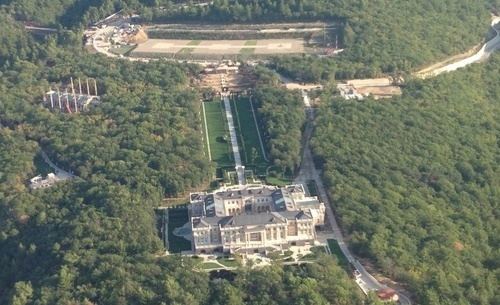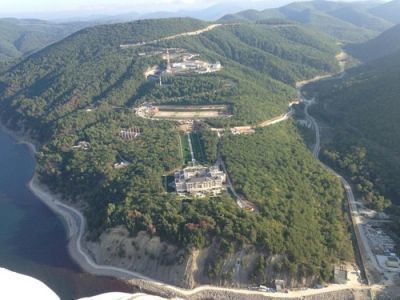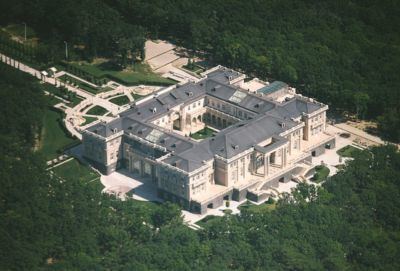Owner Alexander Ponomarenko Construction started 2005 | Cost 1 billion USD (estimate) | |
 | ||
Alternative names Palace on the Idokopas Cape, villa on the Cape of Idokopas, "Putin's Palace", "dacha Putin" Similar Sail Rock, Novo‑Ogaryovo, Konstantin Palace, Vladimir Putin Peak, Meyendorff Castle | ||
PUTIN'S SECRET PALACE DOCUMENTARY
The Residence at Cape Idokopas (Russian: Резиденция на мысе Идокопас). also known as the "Palace on the Idokopas Cape", often called in the media "Putin's Palace", "Dacha Putin", or "Putin’s country cottage", is a large Italianate palace complex located on the Black Sea coast near the village of Praskoveevka in Gelendzhik, Krasnodar Krai, Russia.
Contents
- PUTINS SECRET PALACE DOCUMENTARY
- Whistleblowers claims
- Cash flow scheme financing of the construction
- Official response
- Other reports
- References
While officially dismissed in 2010 by Vladimir Putin's spokesman Dmitry Peskov, it has been claimed that the dacha was built for the personal use of President Putin, and that its construction began during his first Presidency. Detailed claims about the project, which allegedly made improper use of state resources, were made by Sergei Kolesnikov, a businessman with ties to Putin dating from his time in Saint Petersburg prior to entering Kremlin politics.

In December 2010 Kolesnikov wrote an open letter to President Dmitry Medvedev detailing the involvement of himself and others in the project and calling for Medvedev to investigate and to take action against corruption in Russia. Good quality photographs of the palace and its extensive grounds were subsequently published by the Russian language WikiLeaks website in January 2011, which showed the apparently complete lavish interior decor. Following the release of the photographs the site was temporarily blocked.

Spokespeople on the behalf of Putin and the Russian government have consistently dismissed Putin's connections to the property and the related allegations of corruption. In February 2011 the independent Russian newspaper Novaya Gazeta reported that it had seen documents which supported Kolesnikov by implicating Vladimir Kozhin, Head of the Presidential Property Management Department, who had denied any involvement. A spokesman refused to comment on the Novaya Gazeta article. The presence of Federal Protective Service (FSO) activity in the area has been claimed as further evidence of state involvement. In April 2011 PPMD head Vladimir Kozhin admitted Kremlin involvement with project when he said that his office was contracted by Lirus Management (Rosinvest, a subsidiary of Lirus, was directly financing the construction of Palace) to carry out the contract for the construction of the palace.

In March 2011 it was reported that the company "Idokopas" which owned around 67 hectares of "recreational" land near the settlement of Praskoveyeka, including a "guesthouse" complex amounting to 26,000 square meters, had been sold for $350 million to Alexander Ponomarenko, a businessman and billionaire with links to Putin who made his money by controlling the Black Sea port of Novorossiysk. Ponomarenko also said he had bought a second company, "Lazurnaya Yagoda" (Azure berry), which owns 60 hectares of agricultural land near Divnomorsk, a settlement 13 kilometers from Praskoveyevka. According to Vedomosti, however, experts think that deal was poor value. $350 million is too much they said, estimating the property at $20 million. Ponomarenko bought the unfinished complex from Nikolai Shamalov, another member of Putin's circle and the businessman at the centre of Kolesnikov's claims, and his partners. While he did not reveal his plans for its use, Ponomarenko confirmed that the property's value would be close to $350 million.

Whistleblower's claims
Kolesnikov's letter to Medvedev and subsequent media interviews, including to Novaya Gazeta, David Ignatius of The Washington Post and Masha Gessen of Snob.ru, give the following account of what the whistleblower revealed was known to its participants as "Project South".
In early 2000, Nikolai Terentievich Shamalov, a representative of the multinational company Siemens AG in North West Russia and somebody thought close to Russia's new President Vladimir Putin, approached Kolesnikov with a business proposition. The two men had known each other through business since 1993-1994, when Kolesnikov was deputy director general of Petromed, a St. Petersburg-based firm that specialised in the procurement of medical supplies. It was also through Petromed that Kolesnikov had got to know Putin, on whose behalf Shamalov said he made the approach. Putin had been head of the St. Petersburg Council on External Economic affairs which when Petromed became a private company in 1992 held a 51% stake.
Putin's plan, as delineated by Shamalov to Kolesnikov, was as follows. Some extremely wealthy Russian businessmen were to provide large sums of money which were to be spent on improving Russia's healthcare infrastructure. They included Roman Abramovich ($203 million) and Alexei Mordashov ($14.9 million). It was arranged that a donation, in the first instance from Abramovich's Pole of Hope charity to the Sergei Kirov Military Medical Academy, would be directed to Petromed as the contractor for the modernisation programme. Kolesnikov said that 15-20% of its contracts with suppliers went to Siemens, run by Shamalov.
However, Putin stipulated that 35% of the funds should be held in offshore accounts rather than spent on the projects for which they were ostensibly intended. The source of these funds was invisible, because Petromed negotiated discounts from its suppliers (including Siemens) which it did not pass on, claiming that it had paid more than it actually had. Thus, according to Kolesnikov, Petromed claimed to have spent Abramovich's $203 million, but in fact spent $130 million. The remaining $70 million found its way to Switzerland, under Shamalov's control. Kolesnikov estimates that by 2007 $500 million had accumulated in Switzerland. In 2005, when around $200 million had been reached, Rosinvest, a subsidiary of the Swiss registered company Lirus Management, was established to invest the money in Russia.
Putin allegedly held 94% of shares in Rosinvest, with Kolesnikov, Shamalov and Dmitry Vladimirovich Gorelov (director of Petromed and another friend of Putin from his time in St Petersburg) taking 2% each. Rosinvest's interests included shipbuilding, construction, and lumber/timber processing. Kolesnikov is reported as saying that Abramovich and the other donors to health projects acted 'nobly', implying they were unaware that a significant proportion of their donations was being diverted into an investment vehicle allegedly run for the benefit of the President and his partners in Rosinvest. This is despite the huge sums involved and disputed claims that the relationship between Putin and Abramovich has been very close.
'Project South', directed by Shamalov, was less mainstream as an 'investment project'. Part one, begun in 2005, was a small 'wellness centre' located at Praskoveevka in 73.96 hectares of protected forest; part two, begun in 2007, was a vineyard in the same area. In the aftermath of the 2008 world financial crisis funds were redirected to Project South from Rosinvest's other projects to facilitate its expansion. It was no longer to be a small 'wellness centre', as the photographs published online by RuLeaks.net show. By this stage, Praskoveevka was home to an Italianate palace of tens of thousands of square metres with casino, winter theatre, summer amphitheatre, church, swimming pools, sports grounds, heliports, landscaped parks, tea houses, staff apartments and technological buildings. Kolesnikov pointedly described it as a modern version of the Peterhof Palace, built on the orders of Peter the Great, and believes that by October 2009 the costs of construction (by the state company Spetsstroi) had reached $1 billion. In addition, it is alleged that money from the state budget was used to provide the complex with infrastructure — a gas supply pipeline, an electric power line, and a new mountain road.
Kolesnikov claims that in 2009 he and others were barred from the project when he objected to Shamalov's circumvention of customs regulations for supplies for the complex. Kolesnikov has expressed the view that the whole scheme was from the outset a balance between good and evil, but that in 2009 the closure of sensible investment projects in favour of the palace was a step too far. He claims that this order came from Putin, to whom he would give progress reports on Rosinvest. He alleges that Shamalov was sacked by Siemens for not answering bribery allegations but in 2009 was registered as the owner of the complex via the companies Indokopas and Rirus.
Cash flow scheme - financing of the construction
The chart below shows the scheme of interaction between companies and cash flows involved in financing of the construction.
Significant financial activity shown on this chart:
- Construction of "Putin's Palace" - estimated cost of construction $1 billion, sold by Nikolai Shamalov for $350 million to Alexander Ponomarenko in 2011,
- Purchase of shares in Bank Rossiya by Nikolai Shamalov and Dmitry Gorelov. Total share as of 2006: Dmitry Gorelov 12.58%, Nikolay Shamalov 12.58% (see: history of Bank Rossiya). As of April 1, 2015 banks assets were worth 508 billion rubles (ranked 17 in Russia, see Bank Rossiya - assets worth),
- Purchase of shares in Согаз (en: Sogaz), a big insurance company in Russia. 12,47% by Accept Ltd (owned by grandson of Vladimir Putin's uncle Michael Shelomov) and 51% by JSC ABRos Investment Company wholly owned by Bank Rossiya (see: subsidiaries of Bank Rossiya),
- Various investments projects in Russia: Vyborg Shipyards, Medical Module Production in Cherepovets, Vineyard in Gelandzhik, Maritime Wharf. Kolesnikov claims that in 2009 development of new investment projects was closed in favour of the palace construction,
- Money from the state budget and state-owned companies was used to provide the complex with infrastructure (gas supply pipeline, electric power line, new mountain road) despite the fact that officially this was private property.
Official response
On 23 December 2010, Dmitry Peskov, spokesman for the Prime Minister, dismissed Kolesnikov's allegations against Putin as untrue, maintaining that the Washington Post report "concerns the ownership connections of various persons and entities, but Putin has never had any relationship to this palace." In February 2011 Vladimir Khozhin listed the official residences operated by the Presidential Property Management Department and asserted that the government does not maintain any residence as described by the media. In April Kozhin admitted Kremlin involvement with project when he said that his office was contracted by Lirus Management to carry out the contract for the construction of the palace.
Other reports
In February 2011, environmentalists and a journalist visited the site to investigate concerns that the construction violated laws protecting the area's ecology. They report that they were harassed and detained by members of the Federal Protective Service (FSO), the agency responsible for guarding state property and high-ranking officials. Despite the confiscation of their equipment they were able to publish additional photographs of the site. Activists made another sortie into the property in June 2011, when they claimed to have found an illegally constructed marina.
